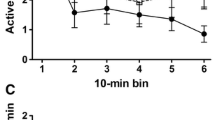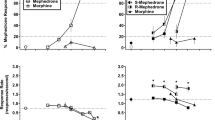Abstract
Two psychomotor stimulants, (+)-amphetamine and apomorphine, were examined for effects on associative learning and responding for a conditioned reinforcer. The experimental phases included: 1) preexposure to an operant test chamber with two levers, each of which produced a neutral stimulus when pressed; 2) pairings of one stimulus with food; and 3) a subsequent test of lever pressing for the two stimuli. Groups of food deprived rats (n=8–12) were given IP injections of one stimulant prior to each pairing or testing session. Given during pairings, (+)-amphetamine produced a dose-related attenuation of responding for the conditioned stimulus in the test; doses of 0.5, 1.0 and 2.0, but not 0.25 or 4.0 mg/kg, given during the test enhanced responding, as did 0.5 mg/kg given in both phases. Apomorphine did not significantly alter responding during testing when administered in either the pairing (0–0.75 mg/kg) or test (0.5–1.0 mg/kg) phase. The results suggest that the modulation of conditioned reinforcement by psychomotor stimulants may occur through a presynaptic influence. Furthermore, the results with (+)-amphetamine suggest that this drug differentially affects the learning of an association between a conditioned and unconditioned stimulus versus the acquisition of responding for that conditioned stimulus.
Similar content being viewed by others
References
Beninger RJ (1983) The role of dopamine in locomotor activity and learning. Brain Res Rev 6:173–196
Beninger RJ, Hanson DR, Phillips AG (1980) The effects of pipradrol on the acquisition of responding with conditioned reinforcement: A role for sensory preconditioning. Psychopharmacology 69:235–242
Beninger RJ, Hanson DR, Phillips AG (1981) The acquisition of responding with conditioned reinforcement: Effects of cocaine, (+)-amphetamine and pipradrol. Br J Pharmacol 74:149–154
Colpaert FC, Van Bever WFM, Leysen JEMP (1976) Apomorphine: Chemistry, pharmacology, biochemistry. Int Rev Neurobiol 19:225–268
Hill RT (1970) Facilitation of conditioned reinforcement as a mechanism of psychomotor stimulants. In: Costa E, Garattini S (eds) International symposium on amphetamines and related compounds. Raven, New York, pp 781–795
Hoffman DC, Beninger RJ (1985) The effects of pimozide on the establishment of conditioned reinforcement as a function of the amount of conditioning. Psychopharmacology 87:454–460
Keesey RE, Kling JW (1961) Amount of reinforcement and free-operant responding. J Exp Anal Behav 4:125–132
Knott PD, Clayton KN (1966) Durable secondary reinforcement using brain stimulation as the primary reinforcer. J Comp Physiol Psychol 61:151–153
Kornblith CL, Hoebel BG (1976) A dose-response study of anorectic drug effects on food intake, self-stimulation, and stimulation-escape. Pharmacol biochem Behav 5:215–218
Lyon M, Robbins TW (1975) The action of central nervous system stimulation drugs: A general theory concerning amphetamine effects. In: Essman W, Valzelli L (eds) Current developments in psychopharmacology vol 2, Spectrum, New York, pp 79–163
Moore KE (1977) The actions of amphetamine on neurotransmitters: A brief review. Biol Psychiatry 12:451–462
Overton DA (1974) Experimental methods for the study of state-dependent learning. Fed Proc 33:1800–1813
Robbins TW (1978) The acquisition of responding with conditioned reinforcement: Effects of pipradrol, methylphenidate, d-amphetamine and nomifensine. Psychopharmacology 58:79–87
Robbins TW, Watson BA, Gaskin M, Ennis C (1983) Contrasting interactions of pipradrol, d-amphetmaine, cocaine, cocaine analogues, apomorphine and other drugs with conditioned reinforcement. Psychopharmacology 80:113–119
Sanger DJ, Blackman DE (1976) Rate-dependent effects of drugs: A review of the literature. Pharmacol Biochem Behav 4:73–83
Scheel-Kruger J (1971) Comparative studies of various amphetamine analogues demonstrating different interactions with the metabolism of the catecholamines in the brain. Eur J Pharmacol 14:47–59
Shettleworth S, Nevin JA (1965) Relative rate of response and relative magnitude of reinforcement in multiple schedules. J Exp Anal Behav 8:199–202
Ungerstedt U, Lunjberg T, Ranje C (1977) Dopamine neurotransmission and the control of behaviour. In: Cools AR, Lohman AHM, van den Berken JHI (eds) Psychobiology of the striatum. North-Holland, Amsterdam, pp 85–97
Westerink BHC (1979) The effects of drugs on dopamine biosynthesis and metabolism in the brain. In: Horn AS, Korf J, Westerink BHC (eds) The neurobiology of dopamine. Academic, London, pp 255–291
Author information
Authors and Affiliations
Rights and permissions
About this article
Cite this article
Mazurski, E.J., Beninger, R.J. The effects of (+)-amphetamine and apomorphine on responding for a conditioned reinforcer. Psychopharmacology 90, 239–243 (1986). https://doi.org/10.1007/BF00181249
Received:
Revised:
Issue Date:
DOI: https://doi.org/10.1007/BF00181249




